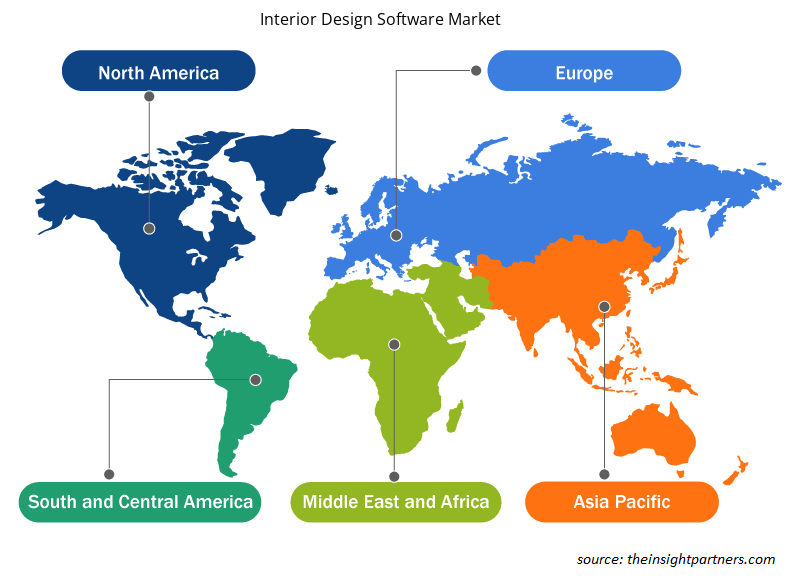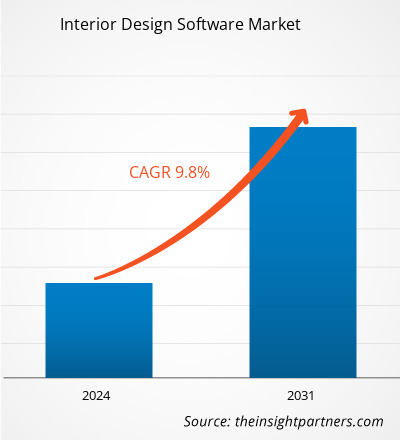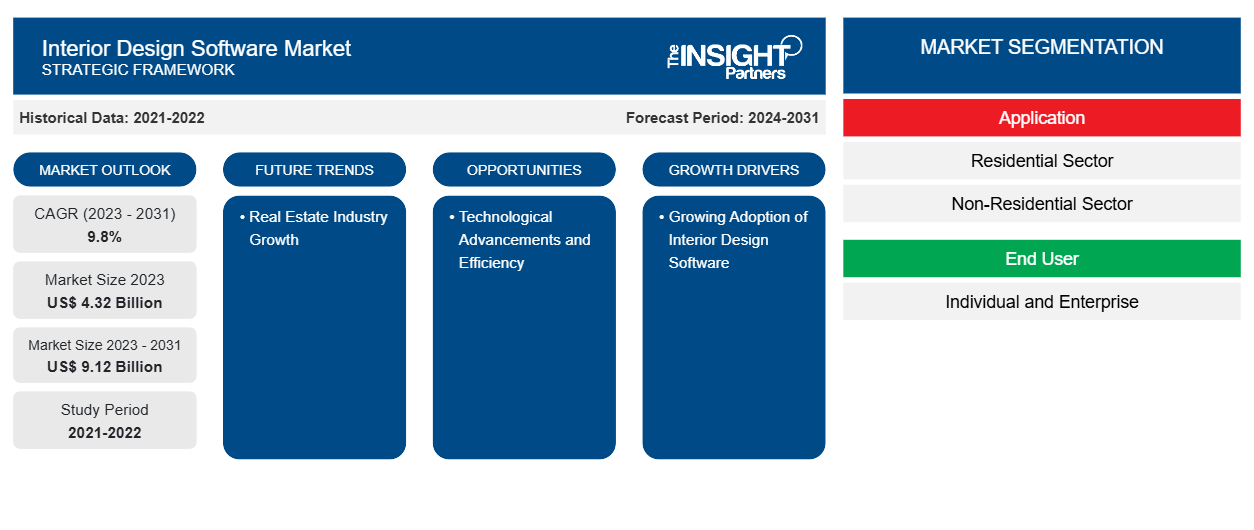Le marché des logiciels de décoration intérieure devrait atteindre 9,12 milliards de dollars d'ici 2031, contre 4,32 milliards de dollars en 2023. Le marché devrait enregistrer un TCAC de 9,8 % au cours de la période 2023-2031. La croissance du secteur immobilier devrait rester une tendance clé du marché.
Analyse du marché des logiciels de décoration d'intérieur
La demande croissante de productivité est l'un des principaux facteurs qui stimulent ce marché. En outre, la demande croissante d'une meilleure conception et décoration intérieure et l'utilisation croissante de logiciels basés sur le cloud stimulent la croissance du marché. Les problèmes d'interopérabilité associés aux logiciels de conception intérieure limitent la croissance de ce marché. En outre, la croissance du processus de virtualisation et la demande de logiciels de conception intérieure, qui croissent à un rythme rapide dans des pays comme la Chine, devraient offrir de multiples opportunités au marché.
Aperçu du marché des logiciels de conception d'intérieur
Le logiciel de conception d'intérieur permet aux architectes d'évaluer rapidement la qualité de l'environnement intérieur. Les architectes peuvent également utiliser ce logiciel pour identifier, suivre et mesurer tout écart du bâtiment conçu par rapport aux critères requis. Ce logiciel permet en outre aux architectes de prendre des mesures préventives pour réduire le besoin de rénovation et de reconstruction. Il dispose également d'une collection complète d'options, telles que des modèles de fenêtres , de portes, de lits et de tables, qu'un concepteur peut utiliser pour créer un modèle exact de la pièce.
Personnalisez ce rapport en fonction de vos besoins
Vous bénéficierez d'une personnalisation gratuite de n'importe quel rapport, y compris de certaines parties de ce rapport, d'une analyse au niveau des pays, d'un pack de données Excel, ainsi que de superbes offres et réductions pour les start-ups et les universités.
-
Obtenez les principales tendances clés du marché de ce rapport.Cet échantillon GRATUIT comprendra une analyse de données, allant des tendances du marché aux estimations et prévisions.
Moteurs et opportunités du marché des logiciels de conception d'intérieur
Adoption croissante des logiciels de conception d'intérieur
L'utilisation croissante de ces logiciels par les architectes, les ingénieurs et les entrepreneurs est un facteur de croissance essentiel pour le marché des logiciels de décoration intérieure. Ils ont contribué de manière significative aux premières étapes de la conception pour évaluer les intérieurs. Ils réduisent les erreurs, permettent une gestion efficace du temps et montrent les différences entre une conception proposée et la construction réelle, améliorant ainsi l'efficacité et la précision globales de son travail en définissant les plans d'étage, les meubles et les décors intérieurs dans un environnement tridimensionnel réaliste.
Progrès technologiques et efficacité
L'augmentation soudaine des activités de construction mondiales, qui s'est produite simultanément avec l'adoption généralisée de logiciels de décoration intérieure pour améliorer l'efficacité opérationnelle, accélère considérablement la croissance du secteur des services de décoration intérieure. Cette tendance est encore renforcée par la capacité de ces logiciels à accélérer le processus de conception, à économiser du temps et des coûts, et à offrir une vaste collection de choix de meubles qui permettent aux concepteurs de créer des modèles de pièces précis et réalistes. Ainsi, l'intégration croissante des logiciels de décoration intérieure facilite non seulement les opérations, mais contribue également à la croissance absolue du marché.
Analyse de segmentation du rapport sur le marché des logiciels de décoration d'intérieur
Les segments clés qui ont contribué à l’élaboration de l’analyse du marché des logiciels de design d’intérieur sont les applications et les utilisateurs finaux.
- En fonction des applications, le marché est divisé en deux secteurs : résidentiel et non résidentiel. Le segment du secteur résidentiel détenait une part de marché importante en 2023.
- En fonction des utilisateurs finaux, le marché est segmenté en particuliers et en entreprises. Le segment des entreprises détenait une part de marché importante en 2023.
Analyse des parts de marché des logiciels de décoration d'intérieur par zone géographique
La portée géographique du rapport sur le marché des logiciels de conception d'intérieur est principalement divisée en cinq régions : Amérique du Nord, Asie-Pacifique, Europe, Moyen-Orient et Afrique, et Amérique du Sud et centrale.
L'aperçu régional du marché des logiciels de décoration intérieure révèle des opportunités de croissance importantes dans diverses régions. En Asie-Pacifique, l'augmentation de la population et de l'urbanisation, en particulier dans les grandes villes telles que Tokyo, Pékin et Bombay, a conduit à une concentration accrue sur les secteurs résidentiels, avec des initiatives telles que la stratégie nationale de développement de la Chine visant une urbanisation substantielle. En outre, l'Asie-Pacifique devrait enregistrer le TCAC le plus élevé du marché au cours de la période de prévision, attribué à l'augmentation des plans d'infrastructures de construction dans des pays comme la Chine et l'Inde, ainsi qu'à l'urbanisation croissante et à l'expansion démographique dans les grandes villes telles que Pékin, Tokyo et Bombay.CAGR in the market during the forecast period, attributed to increasing
Aperçu régional du marché des logiciels de décoration d'intérieur
Les tendances régionales et les facteurs influençant le marché des logiciels de décoration intérieure tout au long de la période de prévision ont été expliqués en détail par les analystes d’Insight Partners. Cette section traite également des segments et de la géographie du marché des logiciels de décoration intérieure en Amérique du Nord, en Europe, en Asie-Pacifique, au Moyen-Orient et en Afrique, ainsi qu’en Amérique du Sud et en Amérique centrale.

- Obtenez les données régionales spécifiques au marché des logiciels de conception d'intérieur
Portée du rapport sur le marché des logiciels de décoration d'intérieur
| Attribut de rapport | Détails |
|---|---|
| Taille du marché en 2023 | 4,32 milliards de dollars américains |
| Taille du marché d'ici 2031 | 9,12 milliards de dollars américains |
| Taux de croissance annuel composé mondial (2023-2031) | 9,8% |
| Données historiques | 2021-2022 |
| Période de prévision | 2024-2031 |
| Segments couverts |
Par application
|
| Régions et pays couverts |
Amérique du Nord
|
| Leaders du marché et profils d'entreprises clés |
|
Densité des acteurs du marché des logiciels de décoration d'intérieur : comprendre son impact sur la dynamique des entreprises
Le marché des logiciels de décoration d'intérieur connaît une croissance rapide, tirée par la demande croissante des utilisateurs finaux en raison de facteurs tels que l'évolution des préférences des consommateurs, les avancées technologiques et une plus grande sensibilisation aux avantages du produit. À mesure que la demande augmente, les entreprises élargissent leurs offres, innovent pour répondre aux besoins des consommateurs et capitalisent sur les tendances émergentes, ce qui alimente davantage la croissance du marché.
La densité des acteurs du marché fait référence à la répartition des entreprises ou des sociétés opérant sur un marché ou un secteur particulier. Elle indique le nombre de concurrents (acteurs du marché) présents sur un marché donné par rapport à sa taille ou à sa valeur marchande totale.
Les principales entreprises opérant sur le marché des logiciels de décoration d'intérieur sont :
- Autodesk Inc.
- Architecte en chef, Inc.
- Dassault Systèmes
- ECDESIGN Suède AB
- RoomSketcher AS
- Roomtodo OU
Avis de non-responsabilité : les sociétés répertoriées ci-dessus ne sont pas classées dans un ordre particulier.

- Obtenez un aperçu des principaux acteurs du marché des logiciels de conception d'intérieur
Actualités et développements récents du marché des logiciels de décoration intérieure
Le marché des logiciels de décoration intérieure est évalué en collectant des données qualitatives et quantitatives après des recherches primaires et secondaires, qui incluent d'importantes publications d'entreprise, des données d'association et des bases de données. Quelques-uns des développements du marché des logiciels de décoration intérieure sont répertoriés ci-dessous :
- IKEA US a annoncé le lancement du service de décoration d'intérieur IKEA, un tout nouveau programme qui propose des services de décoration d'intérieur personnalisés et professionnels à un prix abordable. Les consommateurs et les entreprises auront la possibilité de se connecter avec un expert pour concevoir n'importe quel espace avec des solutions créatives.
(Source : Inter IKEA Systems BV, site Web de l'entreprise, avril 2023)
- Ingka Group, le plus grand détaillant IKEA, lance aujourd'hui sa nouvelle expérience de conception numérique basée sur l'intelligence artificielle, IKEA Kreativ. Cette nouvelle expérience intuitive offre aux clients la première manière réaliste et entièrement intégrée de concevoir et de visualiser leurs propres espaces de vie à partir d'ordinateurs et de smartphones.
(Source : Inter IKEA Systems BV, site Web de l'entreprise, juillet 2022)
Rapport sur le marché des logiciels de décoration d'intérieur : couverture et livrables
Le rapport « Taille et prévisions du marché des logiciels de design d’intérieur (2021-2031) » fournit une analyse détaillée du marché couvrant les domaines ci-dessous :
- Taille et prévisions du marché des logiciels de conception d'intérieur aux niveaux mondial, régional et national pour tous les segments de marché clés couverts par le périmètre
- Tendances du marché des logiciels de décoration intérieure, ainsi que la dynamique du marché, comme les facteurs moteurs, les contraintes et les opportunités clés
- Analyse détaillée des cinq forces de PEST/Porter et SWOT
- Analyse du marché des logiciels de décoration intérieure couvrant les principales tendances du marché, le cadre mondial et régional, les principaux acteurs, les réglementations et les développements récents du marché
- Analyse du paysage industriel et de la concurrence couvrant la concentration du marché, l'analyse de la carte thermique, les principaux acteurs et les développements récents sur le marché des logiciels de décoration intérieure
- Profils d'entreprise détaillés
- Analyse historique (2 ans), année de base, prévision (7 ans) avec TCAC
- Analyse PEST et SWOT
- Taille du marché Valeur / Volume - Mondial, Régional, Pays
- Industrie et paysage concurrentiel
- Ensemble de données Excel
Rapports récents
Rapports connexes
Témoignages
Raison d'acheter
- Prise de décision éclairée
- Compréhension de la dynamique du marché
- Analyse concurrentielle
- Connaissances clients
- Prévisions de marché
- Atténuation des risques
- Planification stratégique
- Justification des investissements
- Identification des marchés émergents
- Amélioration des stratégies marketing
- Amélioration de l'efficacité opérationnelle
- Alignement sur les tendances réglementaires























 Obtenez un échantillon gratuit pour - Marché des logiciels de design d'intérieur
Obtenez un échantillon gratuit pour - Marché des logiciels de design d'intérieur